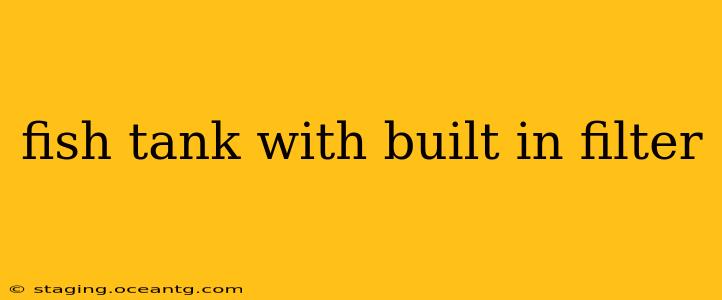Choosing the right fish tank can be overwhelming, especially when considering the crucial aspect of filtration. A fish tank with a built-in filter offers convenience and often a more aesthetically pleasing setup compared to separate filter units. This comprehensive guide will explore the various types, benefits, considerations, and frequently asked questions surrounding these all-in-one aquarium systems.
What are the Different Types of Built-in Filter Systems?
Several types of built-in filters cater to different tank sizes and setups. The most common include:
-
Undergravel Filters (UGF): These utilize a porous plate beneath the substrate, drawing water through the gravel and up into a powerhead. While budget-friendly, they require meticulous maintenance and aren't ideal for all types of fish or substrates.
-
Internal Filters: These are compact and submerged within the tank itself. They're easily hidden and commonly found in smaller all-in-one tank kits. They offer good filtration for smaller tanks but may not be suitable for larger setups or those with demanding filtration needs.
-
Hang-on-Back (HOB) Filters (Integrated): Some all-in-one tanks incorporate HOB filters seamlessly into the tank's design. This offers a balance of performance and aesthetics. They are relatively easy to maintain and replace. This type often offers better filtration capacity than internal filters.
-
Canister Filters (Integrated): Though less common in truly "built-in" designs, some higher-end all-in-one aquarium systems incorporate a canister filter system within the tank's cabinetry or stand. These provide the most robust filtration, capable of handling larger tanks and demanding fish species.
What are the Benefits of a Fish Tank with a Built-in Filter?
Opting for a tank with an integrated filter system presents several advantages:
-
Space-Saving Design: Eliminates the need for a separate filter unit, resulting in a cleaner, more uncluttered aquarium aesthetic.
-
Ease of Setup: Simplifies the initial setup process as the filter is already integrated.
-
Concealed Filtration: The filter is often hidden, maintaining the visual appeal of the tank.
-
Often Easier Maintenance: Depending on the system, cleaning and maintenance may be easier than with separate external filters.
How Do I Choose the Right Built-in Filter System for My Needs?
Selecting the right system depends on several factors:
-
Tank Size: The filter's capacity must match the tank's volume to ensure adequate filtration.
-
Fish Species: The filtration needs vary drastically depending on the fish kept. More demanding fish require higher filtration rates.
-
Substrate Type: Certain filter systems, like UGFs, are not compatible with all substrates.
-
Budget: Prices range significantly depending on the tank size and filter type.
What are the Potential Drawbacks of Built-in Filters?
While convenient, built-in systems can have some limitations:
-
Limited Filter Media Options: Some integrated filters offer less flexibility in customizing filter media compared to separate filter units.
-
Repair and Replacement Challenges: Replacing or repairing a built-in filter can be more complex and sometimes require professional assistance.
-
Accessibility Issues for Cleaning: Cleaning the filter may be less convenient than with easily removable separate units.
What Size Tank is Best with a Built-in Filter?
The ideal tank size for a built-in filter system depends on the specific filter's capacity. Smaller tanks (under 20 gallons) often utilize internal or integrated HOB filters effectively. Larger tanks often benefit from more robust integrated canister systems or may require a supplemental filter for optimal water quality.
How Often Should I Clean a Built-in Filter?
The cleaning frequency depends on the type of filter and the bioload (number of fish and their waste production). Generally, it's advisable to partially clean the filter media every 2-4 weeks, replacing some of the old media with fresh media. Avoid completely replacing all the media at once to protect beneficial bacteria crucial for water quality.
Are Built-in Filters More Expensive Than Separate Filters?
The cost depends on the entire aquarium system. While the initial purchase price of an all-in-one tank with a built-in filter might be comparable to a tank and a separate filter unit, factors like future maintenance and filter media replacement should be considered when comparing total cost.
This comprehensive guide offers an in-depth look at choosing the right fish tank with a built-in filter system. Remember to carefully consider your needs and preferences before making your purchase to ensure a successful and enjoyable aquarium experience.
